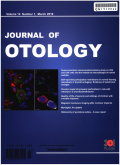- 钛学术文献服务平台 \
- 学术期刊 \
- 医药卫生期刊 \
- 五官科学期刊 \
- 中华耳科学杂志(英文版)期刊 \
Primary endoscopic stapedotomy using 3 mm nasal endoscope: Audiologic and clinical outcomes
Primary endoscopic stapedotomy using 3 mm nasal endoscope: Audiologic and clinical outcomes
基本信息来源于合作网站,原文需代理用户跳转至来源网站获取
摘要:
Objective: To report the use of a 3 mm rigid nasal endoscope in primary endoscopic stapedotomy and clinical and audiological outcomes.Materials and methods: Thirty patients diagnosed with primary otosclerosis underwent endoscopic stapedotomy that was performed using a 3 mm nasal endoscope (Karl Storz). At 6 months follow-up, the patients were evaluated for intraoperative findings, postoperative hearing outcomes and complications. Results: Canaloplasty was performed in 2 (6.66%) patients, and no curettage of the canal wall was required in 12 (40%) patients. Transposition of the chorda tympani nerve was conducted in 11 (36.66%) patients. The average duration of surgery was 36 min (range 31-65 min). The air-bone gap (ABG) was 35 dB (range 24-50 dB) preoperatively and 14.63 dB (range 9-20 dB) postoperatively (p = 0.00). At 6 months follow-up, <20 dB ABG was achieved in 93.33% of the patients. No major intraoperative/post-operative complications were detected. Conclusion: A 3 mm rigid nasal endoscope can be effectively used in stapedotomy to obtain adequate audiological outcomes. It can be considered as a better alternative to the standard microscope or 4 mm endoscope in preserving the posterior canal wall and chorda tympani nerve while minimizing operative time without causing significant complications.

推荐文章
200 mm×60 mm×3 mm矩形钢管孔型设计
焊接钢管
方矩形管
孔型设计
Ф3 600mm造气炉节能改造
造气炉
炉箅改进
节能降耗
Determination of brominated diphenyl ethers in atmospheric particulate matter using selective pressu
Brominated diphenyl ethers
Atmospheric particulate matters
Selective pressurised liquid extraction
Gas chromatography-mass spectrometry
3mm与8mm波段水面金属目标的辐射特性检测方法
辐射率
辐射计
水面金属目标
视在温度
内容分析
关键词云
关键词热度
相关文献总数
(/次)
(/年)
文献信息
| 篇名 | Primary endoscopic stapedotomy using 3 mm nasal endoscope: Audiologic and clinical outcomes | ||
| 来源期刊 | 中华耳科学杂志(英文版) | 学科 | |
| 关键词 | |||
| 年,卷(期) | 2020,(4) | 所属期刊栏目 | Research Articles |
| 研究方向 | 页码范围 | 133-137 | |
| 页数 | 5页 | 分类号 | |
| 字数 | 语种 | 英文 | |
| DOI | |||
五维指标
引文网络
引文网络
二级参考文献 (21)
共引文献 (4)
参考文献 (19)
节点文献
引证文献 (0)
同被引文献 (0)
二级引证文献 (0)
1900(1)
- 参考文献(1)
- 二级参考文献(0)
1990(1)
- 参考文献(0)
- 二级参考文献(1)
2000(2)
- 参考文献(1)
- 二级参考文献(1)
2003(1)
- 参考文献(0)
- 二级参考文献(1)
2004(1)
- 参考文献(0)
- 二级参考文献(1)
2006(2)
- 参考文献(1)
- 二级参考文献(1)
2008(2)
- 参考文献(1)
- 二级参考文献(1)
2009(3)
- 参考文献(1)
- 二级参考文献(2)
2010(1)
- 参考文献(0)
- 二级参考文献(1)
2011(3)
- 参考文献(0)
- 二级参考文献(3)
2012(2)
- 参考文献(1)
- 二级参考文献(1)
2013(4)
- 参考文献(1)
- 二级参考文献(3)
2014(2)
- 参考文献(1)
- 二级参考文献(1)
2016(7)
- 参考文献(4)
- 二级参考文献(3)
2017(3)
- 参考文献(2)
- 二级参考文献(1)
2018(2)
- 参考文献(2)
- 二级参考文献(0)
2019(2)
- 参考文献(2)
- 二级参考文献(0)
2020(1)
- 参考文献(1)
- 二级参考文献(0)
2020(1)
- 参考文献(1)
- 二级参考文献(0)
- 引证文献(0)
- 二级引证文献(0)
引文网络交叉学科
相关学者/机构
期刊影响力
中华耳科学杂志(英文版)
主办单位:
解放军总医院耳鼻咽喉科研究所
出版周期:
季刊
ISSN:
1672-2930
CN:
11-4883/R
开本:
出版地:
北京市复兴路28号
邮发代号:
创刊时间:
语种:
eng
出版文献量(篇)
450
总下载数(次)
0
总被引数(次)
399
期刊文献
相关文献
推荐文献
- 期刊分类
- 期刊(年)
- 期刊(期)
- 期刊推荐

 免费查重
免费查重










